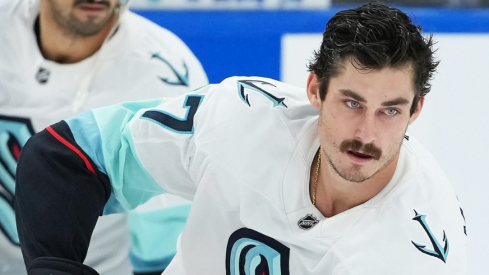Some folks can't stand the mere mention of analytics in hockey.
But in recent years, the use of data has become more commonplace; teams track a wide array of information and disperse it to their coaches and players. It's no longer black and white — we're starting to see a true blend of new age (analytics) and the old school (eyeball test).
Analytics are much like terms you hear from Wall Street; they can be complicated, perhaps to the detriment of mass consumption, but the concepts are quite simple. This excellent advanced stats primer should help, but if that fails and you're feeling confused or just want to talk, drop a line in the comments section.
The Columbus Blue Jackets are 5-1-0 on the season, tied for the best start in the franchise's history. They've outscored their opponents 21-13 and have won four straight games to lead the Metropolitan Division. In this case, the numbers don't lie: the Blue Jackets are equally impressive when we look at their performance through an analytics lense.
The Good
Note: statistics are courtesy of corsica.hockey and naturalstattrick.com, and more often than not, we'll reference stats from 5-on-5 (5v5) play. Why? Charlie O'Connor from The Athletic explains:
"To start, 5v5 is the most frequent situation in all of hockey. Last season, about 78% of the total minutes in the NHL were played at 5v5. Second, by nature, the two teams are on equal footing when they are playing five-aside hockey. Therefore, both teams (in theory) have an equal chance to “drive play” in their direction and win the shot and goals battles. This obviously isn't the case when one team is a player up."
Raised Expectations
Let's start here: the Blue Jackets are tied fourth in the NHL with 16 5-on-5 goals. They are third in the NHL in "expected goals for" (xGF) with 13.92.
Only the Toronto Maple Leafs and Pittsburgh Penguins can expect more goals than the 13.92 that the Blue Jackets have scored. On a percentage rate, the Blue Jackets are fourth at 58.49, meaning they are expected to score 58.49 percent of all goals scored at 5-on-5. Over the course of a season, that is dominant.
The season is still young, so sample size is a factor here. But the point is that the Blue Jackets are scoring goals at the same pace that they'd expect based on their play. Luck is not a major factor, suggesting that their current pace is sustainable.
Shots, Shots, Shots
The Blue Jackets are sixth in the NHL in Corsi For (CF%) at 55.3, meaning they have produced 55.3 percent of all 5-on-5 shot attempts in their first six games. Anything over 50% insinuates that the club is driving play and they're trending in the right direction.
All but two skaters (Nick Foligno and Ryan Murray) have an individual CF% above 50 percent but both are within reach of breaking even (-3 and -4 shot differential, respectively). Rookie forward Pierre-Luc Dubois (60.66%) and defenseman Zach Werenski (60.11%) lead the team in individual Corsi.
Defensive Dominance
Generating shots hasn't been the only strength of the Blue Jackets in the early going. They're also doing a solid job suppressing shots, a measure that separates fun teams from good teams. Columbus allows 50.99 shot attempts per game, which is second-best in the NHL.
In a nutshell: the Blue Jackets are playing well defensively in addition to their work in the offensive end.
They've allowed only eight 5-on-5 goals — sixth-fewest in the NHL. The Blue Jackets' expected goals against (xGA) is 9.88, good enough for 12th overall.
First Line Takeover
Enough about team play. Who is driving this dominance?
The top line of Artemi Panarin, Alexander Wennberg, and Cam Atkinson has a CF% of 63.19 percent, second-best in the NHL behind the Nashville Predators' trio of Filip Forsberg, Ryan Johansen, and Viktor Arvidsson. The line's xGF is 3.96, third in the NHL among all lines. What does this mean? Expectations meet reality and luck isn't playing a role in their success. Their habits are producing offense.
Bobrovsky is Ridiculous
Sergei Bobrovsky is playing out of his mind. His 5-on-5 save percentage is second in the NHL, but his "high-danger save percentage" of .947% not only leads the NHL, but is actually better than all but five other goalies' normal save percentage. Bobrovsky has fared better on high-danger plays than 90 percent of NHL goalies do on normal shots.
The Bad
Power Play Woes
In case you hadn't heard, the Blue Jackets power play is bad right now. They rank dead last in expected goals for (xGF) on the power play with just 2.45 goals/60. Not good!
The Blue Jackets could play 60 minutes with a man-advantage and expect to score 2.45 goals. For comparison's sake: the league mean is around 5.0, and the Maple Leafs currently lead the way with 10.25 xGF on the power play.
John Tortorella has been begging his club to shoot more on the power play, and for good reason. Making matters worse is their power play shooting percentage; only Werenski has scored a power play goal, so a 5.56 percent shooting clip on the power play shouldn't come as a surprise. Somehow, that's only 26th in the NHL, and also significantly lower than their 12th place 5-on-5 shooting percentage of 8.74.
Takeaways
With all of this information, what do we know? The NHL season is only two weeks old, so we should proceed with caution — but there is plenty to like about what the Blue Jackets have done so far.
But as the old saying goes, three's a trend, and the Blue Jackets have won four straight. By that thinking, these statistics (at a minimum) prove that the Blue Jackets are a legitimately good team, and should be reckoned with as the season goes along.


